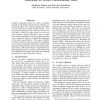Free Online Productivity Tools
i2Speak
i2Symbol
i2OCR
iTex2Img
iWeb2Print
iWeb2Shot
i2Type
iPdf2Split
iPdf2Merge
i2Bopomofo
i2Arabic
i2Style
i2Image
i2PDF
iLatex2Rtf
Sci2ools
COLING
2000
2000
Layout and Language: Integrating Spatial and Linguistic Knowledge for Layout Understanding Tasks
Complex documents stored in a flat or partially marked up file format require layout sensitive preprocessing before any natural language processing can be carried out on their textual content. Contemporary technology for the discovery of basic textual units is based on either spatial or other content insensitive methods. However, there are many cases where knowledge of both the language and layout is required in order to establish the boundaries of the basic textual blocks. This paper describes a number of these cases and proposes the application of a general method combining knowledge about language with knowledge about the spatial arrangement of text. We claim that the comprehensive understanding of layout can only be achieved through the exploitation of layout knowledge and language knowledge in an inter-dependent maimer.
Related Content
| Added | 01 Nov 2010 |
| Updated | 01 Nov 2010 |
| Type | Conference |
| Year | 2000 |
| Where | COLING |
| Authors | Matthew Hurst, Tetsuya Nasukawa |
Comments (0)

